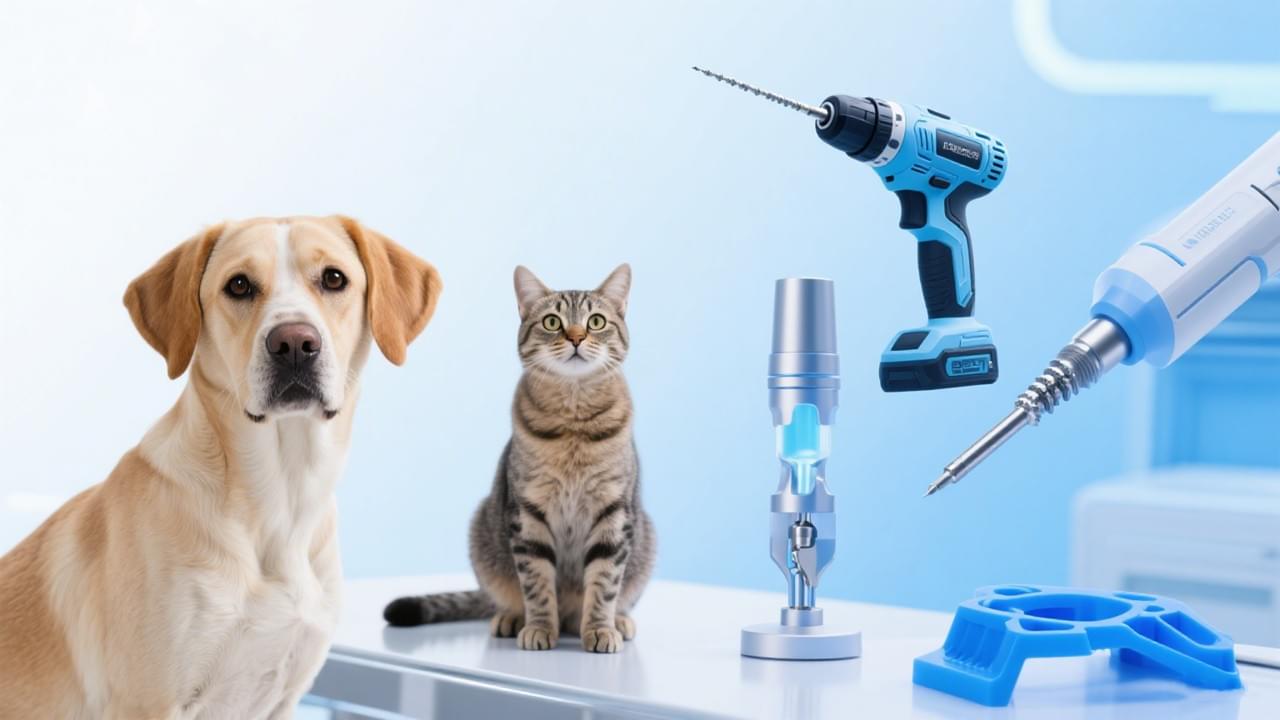Osteoarthritis in pets is the most common orthopedic challenge veterinarians face today, affecting 20% of adult dogs and 14% of cats over eight years old. With pet ownership rising—especially among millennials who treat pets as family—the demand for precise, minimally invasive treatment is stronger than ever. This article explores how modern veterinary orthopedic devices improve diagnosis, surgical precision, recovery speed, and long-term outcomes for pets living with osteoarthritis.
1. Why Early and Accurate Diagnosis Matters
Osteoarthritis (OA) begins silently, often years before a pet shows visible lameness. Detecting OA early helps improve comfort, preserve mobility, and cut treatment costs by nearly 30%. Veterinarians now rely on:
- High-resolution radiographs to stage cartilage loss and bone changes
- 3-D CT or MRI scans for complex joints such as elbows and hocks
- Gait analysis systems to measure stride imbalances with pinpoint accuracy
- Synovial fluid testing to rule out inflammatory joint disease
Today’s advanced imaging allows data to be converted into 3-D printed models and custom surgical guides. These tools ensure every intervention is tailored to the pet’s anatomy, increasing precision and reducing complications.
2. Surgical Interventions: Modern Options Beyond Medication
While NSAIDs, weight management, and newer biologics remain first-line treatments, surgery becomes critical for severe or refractory cases. Key procedures include:
- Arthroscopy for cartilage and fragment removal
- TPLO and TTA surgeries for cranial cruciate ligament rupture
- Femoral head ostectomy (FHO) or total hip replacement (THR) for advanced hip dysplasia
These interventions demand absolute accuracy. Today’s cordless veterinary orthopedic drills with torque control—like those from Vsun Medical—enable safe bone preparation without overheating or causing microfractures. Coated titanium drill bits further extend service life, lowering costs for clinics.
3. How Modern Veterinary Devices Improve Outcomes
3.1 Reduced Surgical Time
Cordless, lightweight drills shorten preparation and procedure time by 20–30%. A 2024 study showed TPLO surgeries completed in 41 minutes with cordless systems, compared to 54 minutes with traditional setups.
3.2 Enhanced Precision and Safety
LED lighting, torque protection, and advanced motors help avoid bone fissures and soft-tissue injury. These features translate to fewer complications and smoother recoveries.
3.3 Faster Recovery and Better Biomechanics
Patient-specific 3-D printed guides reduce bone-cutting errors, leading to improved joint alignment and a 26% faster return to activity. Owners notice better gait symmetry and quicker mobility restoration.
4. Post-Operative Care and Rehabilitation
Post-op care is as vital as surgery itself. Innovations include:
- Locking titanium plates that provide stability with less soft tissue irritation
- Early access to underwater treadmill therapy and laser rehabilitation within 72 hours
- Disposable drill sleeves for guaranteed sterility, essential for small clinics offering outpatient services
Flexible supply chains, including low minimum order quantities (MOQ), allow smaller practices to access premium consumables without excess inventory.
5. Balancing Cost and Long-Term Value
Though advanced surgeries like THR may exceed $4,000, the cost of long-term NSAID use and repeated diagnostics often surpasses this over time. Practices adopting modern devices benefit from:
- Tiered surgical options for different client budgets
- Reduced anesthesia time, lowering patient risk
- A 35% increase in referrals as advanced equipment attracts new cases
6. Looking Ahead: Smart Surgery and Regenerative Medicine
The next wave in veterinary orthopedics includes:
- Sensor-equipped drills that transmit real-time torque and temperature data to tablets
- Machine-learning tools that warn of bone breakthrough
- 3-D printed cartilage scaffolds infused with stem cells, aiming to restore rather than replace damaged tissue
These advances signal a future where osteoarthritis care is less invasive, more predictive, and regenerative rather than palliative.
Takeaway: Compassion Meets Technology
Osteoarthritis in pets is no longer an irreversible decline. With early detection, advanced surgical planning, and precision-engineered devices, veterinarians can restore mobility and extend a pet’s active years. Clinics that invest in modern veterinary orthopedic devices—from drills and saws to 3-D printed guides—position themselves as leaders in compassionate, future-ready care.
Ready to elevate your practice? Discover Vsun Medical’s line of veterinary orthopedic devices—engineered for precision, backed by warranty, and trusted worldwide. Request a free demo today and experience how technology transforms outcomes in osteoarthritis cases.


